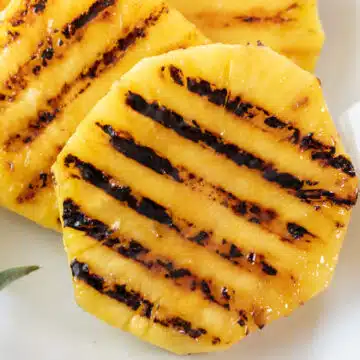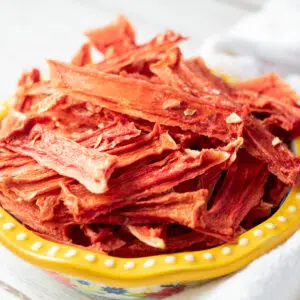This fruits that start with X list contains plenty of unique and delicious fruits from all around the world! You probably haven't heard of many of these, but you will want to try them after you learn about them! There are tropical fruits, common fruits, and so much more!

Jump to:
- 10 Fruits Beginning With X
- 1. Xanthium Strumarium
- 2. Xarel-lo
- 3. Xerophyte
- 4. Xiangjiao
- 5. Xigua
- 6. Ximenia Americana
- 7. Ximenia Caffra
- 8. Xinomavro Grape
- 9. Xoconostle
- 10. Xylocarpus Granatum
- Best Fruits That Start With X
- 📖 Recipe Card
- Fruits That Start With X: 10+ Tasty Fruits To Try Today!
- 💬 Comments & Reviews
10 Fruits Beginning With X
We all know that X is a difficult letter to work with, especially when searching for fruits! I managed to find a handful of delicious fruits that all begin with X for you to try!
A few of them are various names for common fruits (such as bananas or pineapples), but many of them are unique and interesting!
1. Xanthium Strumarium
Xanthium Strumarium, commonly known as the cocklebur, originally comes from North America but has spread to Australia, New Zealand, and South America, earning a reputation as an invasive weed. In China, the prickly fruits of this plant are used for their medicinal properties.
2. Xarel-lo
Xarel-lo grapes, originating from Spain, are a light-colored variety known for producing bold-flavored wines. Grown mainly in Catalonia, this grape is a key ingredient in making a regional favorite, Cava - a sparkling wine readily available at local grocery or European stores.
With a white or green color and occasional brown dots on the skin, xarel-lo stands out for its strong aroma and distinct flavor, making it a favorite among winemakers.
3. Xerophyte
A xerophyte is a special plant that can survive in environments with very little water. These plants, like cacti and pineapples, are often found in dry areas such as deserts and rocky slopes.
The pineapple, a common fruit, is a remarkable xerophyte. It has thick, waxy skin to conserve water and spiny toughness to protect itself from being eaten.

4. Xiangjiao
Xiangjiao, the Chinese name for bananas, brings us to a familiar fruit. Widely available in local grocery stores, bananas are popular worldwide for their year-round availability and unique ripening process.
Beyond being a versatile and convenient fruit, they are often used as a tasty substitute in various desserts like muffins, cookies, cakes, and crêpes.

5. Xigua
Xigua, also known as your typical watermelon, gets its name from Mandarin, where "xigua" literally means "common watermelon." Of course, in America, we simply call it a watermelon.
Recognizable by its dark green striped rind, the juicy and refreshing pulp inside can be either a vibrant red or yellow. Most xigua fruits contain dark black seeds, although some varieties are seedless.

6. Ximenia Americana
Ximenia Americana, commonly called hog plum or sea lemon, is primarily a wild-growing fruit found in wooded areas across Africa, Asia, and America. This fruit, also known as ximenia, is enjoyed in various ways - whether eaten raw, used in juices, jams, or even incorporated into alcoholic drinks.
7. Ximenia Caffra
Ximenia Caffra fruits, also known as sourplums, originate from tropical Africa and thrive in East and Southeast African nations like Kenya, Malawi, Mozambique, Uganda, and South Africa. The oblong fruit, measuring less than 2" in length and an inch in diameter, has red skin when ripe and contains an orange to red juicy pulp.
Widely used for making jams and jellies, this fruit is loved for its sweet and tangy flavor.
>>>>See all of my recipes here<<<<
8. Xinomavro Grape
The xinomavro grape, native to Greece, gets its name from "xino," meaning sour, and "mavro," meaning black. While these dark grapes might sound tart, they are primarily used to make a variety of wines, including sweet blends, table reds, and sparkling options.
Despite their unsuitability for fresh consumption due to their sour taste and numerous seeds, xinomavro grapes make a great bottle of wine.
9. Xoconostle
Xonocostle fruit belongs to the family of cactus fruits. Unlike sweet cactus varieties like the prickly pear, xonocostle is known for its pronounced sourness.
Typically not consumed fresh, these fruits are commonly used in Mexican cuisine, especially in dishes such as mole de olla, where their tart flavor enhances the richness of beef stew. Sold mostly in dried form, sugar or salt is added during the drying process for preservation and improved taste.
10. Xylocarpus Granatum
The xylocarpus granatum tree, also known as the puzzle nut tree, cannonball mangrove, or cedar mangrove, is found in Africa, Asia, Australia, and the Pacific Islands. This mangrove species produces brown and woody fruits, which resemble grapefruits and coconut.
The ripe fruit, with a cheese-like flavor, easily splits into four sections. Though classified as a fruit, it's often cooked like a vegetable, making xylocarpus a tasty addition to both sweet and savory dishes.
Best Fruits That Start With X
This list is pretty short, but I'd love to try all of them! Of course, pineapples, bananas, and watermelon are well-loved favorites of mine.
However, I would love to try some wine made with xarel-lo grapes!
Which one of these fruits that starts with X do you want to try first? Leave a comment and let me know!
Do you love a recipe you tried? Please leave a 5-star 🌟rating in the recipe card below and/or a review in the comments section further down the page.
Stay in touch with me through social media @ Pinterest, Facebook, Instagram, or Twitter! Subscribe to the newsletter today (no spam, I promise)! Don't forget to tag me when you try one of my recipes!
📖 Recipe Card
Fruits That Start With X: 10+ Tasty Fruits To Try Today!
Ingredients
- 1 large pineapple (peeled and cored, cut into ¾ inch slices or wedges)
- 3 tablespoon butter (melted)
- 1 tablespoon honey
- 1 teaspoon Thai sweet chili sauce
- 1 pinch salt (to taste)
(Note: 2x or 3x only changes the ingredient list)
Instructions
- Prepare the 1 large pineapple by trimming off the top and bottom then slicing down the sides. Cut the fresh pineapple into rings, spears, or chunks (based on your preference).
- Transfer the pineapple into a large ziptop storage bag. Add the 3 tablespoon butter, 1 tablespoon honey, 1 teaspoon Thai sweet chili sauce, and 1 pinch salt to the pineapple.
- Seal the bag and shake the pineapple gently to coat. Allow to marinate at room temp for 30 minutes, or refrigerate to marinate for 1 hour or more (up to overnight).
- Clean and oil your grill, then preheat to medium high heat (375-450°F/191-232°C).
- Grill the marinated pineapple for 2-3 minutes per side over direct heat. Brush with the excess marinade while grilling if desired.
- Remove from heat when tender and caramelized. Serve immediately while warm, or after your meal and slightly cooled.
Notes
- Before grilling your pineapple, twist the top off and flip upside down to get the fruit as juicy as possible. Do this a day or two in advance for best results.
- Try hot sauce instead of sweet chili sauce for a hot kick to this treat!
- Wedges or chunks can be threaded onto skewers for easier grilling.
- Transfer to an airtight storage container once cooled to store for up to 5-6 days.
- Flash freeze on a baking sheet, then transfer into a heavy-duty freezer storage bag. Frozen pineapple can keep for up to a year.



Comments
No Comments